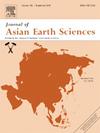准噶尔盆地卢卡沟页岩的石油生成、保留和排出过程:改良膨胀实验和盆地建模的制约因素
IF 2.7
3区 地球科学
Q2 GEOSCIENCES, MULTIDISCIPLINARY
引用次数: 0
摘要
生成油的溶解度参数由不同油分的相对比值决定,在不同的成熟阶段变化显著。然而,以往基于单一溶剂的溶胀实验只能表征一种油分的留油行为,影响了残留干酪根留油能力的准确评价。本研究以准噶尔盆地下二叠统芦草沟(P1l)页岩的干酪根为研究对象,进行了闭系统热解实验,获得了生油过程的动力学参数。同时进行了膨胀实验,以评价残余干酪根的留油量。与以往的溶胀实验不同,我们选择乙酸乙酯和异辛烷的混合物作为溶胀溶剂,并调整相对比例,使每种混合物的溶解度参数在每个热解温度下尽可能接近生成油。基于热解和溶胀实验结果,建立了生油-留油-排油动力学模型(GRE模型)。该动力学模型表明,芦草沟页岩的生油在热成熟度达到0.92%时开始从页岩中排出。利用PetroMod软件,将GRE模型应用于页岩的生、留、排油过程。结果表明,晚侏罗世(约150 Ma)页岩开始出油。目前页岩生、留、排油质量分别为12.3、6.3、6.0 × 106吨/km2。本文章由计算机程序翻译,如有差异,请以英文原文为准。

Oil generation, retention and expulsion processes of the Lucaogou shale in the Junggar Basin: Constraints from improved swelling experiment and basin modelling
The solubility parameters of generated oil are determined by the relative ratios of different oil fractions and vary significantly at different maturation stages. However, previous swelling experiments based on single solvent could only represent the retention behavior for one of oil fractions, which has influence on the accurate evaluation of oil-retention capacity on residual kerogen. In this study, the kerogen of the Lower Permian Lucaogou (P1l) shale from the Junggar Basin was used to conduct the closed-system pyrolysis experiments and the kinetic parameters were obtained for the evaluation of oil-generation process. The swelling experiments were also performed to evaluate oil-retention amount on residual kerogen. Unlike previous swelling experiments, we chose the mixture of ethyl acetate and iso-octane as swelling solvents, and adjusted the relative ratios to bring the solubility parameter of each mixture close to the generated oil for each pyrolysis temperature as possible. The kinetic model oil generation-retention-expulsion (GRE model) was established based on the results of pyrolysis and swelling experiments. This kinetic model showed that the generated oil of the Lucaogou shale started to expel from the shale when the thermal maturity reached 0.92 %. Furthermore, the GRE model was applied to recover oil generation, retention and expulsion processes of the shale by PetroMod software. The results showed that the generated oil started to expel from the shale at the Late Jurassic (approximately 150 Ma). The current masses of generated, retained and expelled oil of the shale are 12.3, 6.3 and 6.0 × 106 tons/km2, respectively.
求助全文
通过发布文献求助,成功后即可免费获取论文全文。
去求助
来源期刊

Journal of Asian Earth Sciences
地学-地球科学综合
CiteScore
5.90
自引率
10.00%
发文量
324
审稿时长
71 days
期刊介绍:
Journal of Asian Earth Sciences has an open access mirror journal Journal of Asian Earth Sciences: X, sharing the same aims and scope, editorial team, submission system and rigorous peer review.
The Journal of Asian Earth Sciences is an international interdisciplinary journal devoted to all aspects of research related to the solid Earth Sciences of Asia. The Journal publishes high quality, peer-reviewed scientific papers on the regional geology, tectonics, geochemistry and geophysics of Asia. It will be devoted primarily to research papers but short communications relating to new developments of broad interest, reviews and book reviews will also be included. Papers must have international appeal and should present work of more than local significance.
The scope includes deep processes of the Asian continent and its adjacent oceans; seismology and earthquakes; orogeny, magmatism, metamorphism and volcanism; growth, deformation and destruction of the Asian crust; crust-mantle interaction; evolution of life (early life, biostratigraphy, biogeography and mass-extinction); fluids, fluxes and reservoirs of mineral and energy resources; surface processes (weathering, erosion, transport and deposition of sediments) and resulting geomorphology; and the response of the Earth to global climate change as viewed within the Asian continent and surrounding oceans.
 求助内容:
求助内容: 应助结果提醒方式:
应助结果提醒方式:


